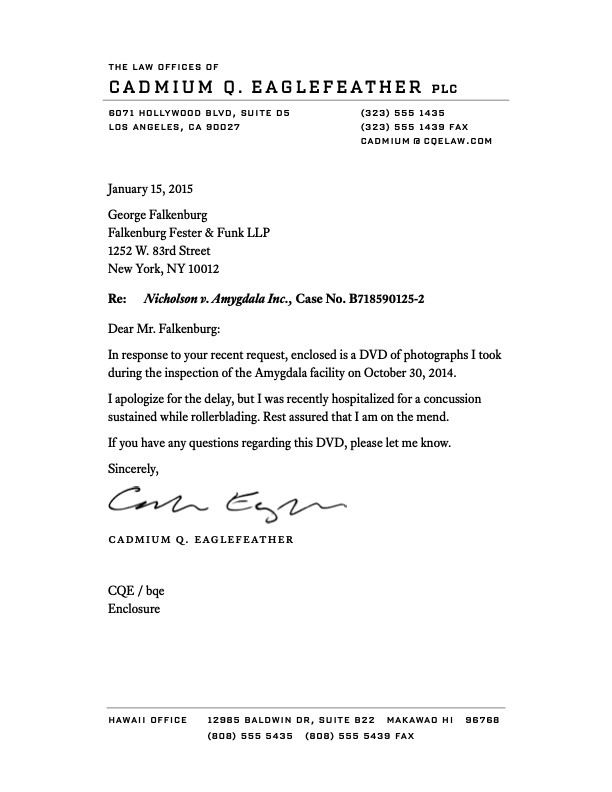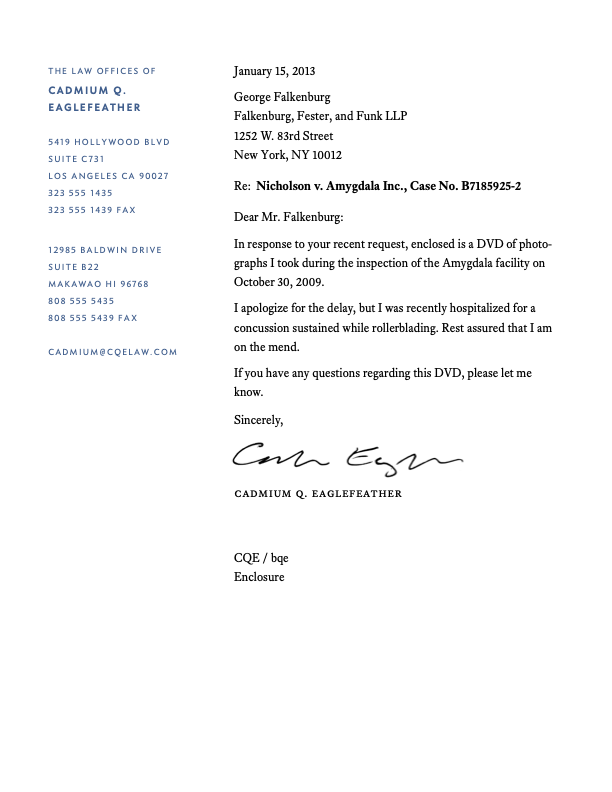Not everything on a page is equally important. As I mentioned in maxims of page layout, I think of documents as having a foreground, containing the most important elements, and a background, containing everything else. Typography communicates this distinction to the reader visually.
Picture a sheet of letterhead. What’s in the foreground? If you said
Yet lawyer letterhead often suffers from two problems. First, the address block (the background) dominates the page, upstaging the text of the letter (the foreground). Second, the foreground and background don’t relate to each other visually.
Too much space wasted in top margin.
Too much centered text.
Long name set in a wide font.
Redundant and unnecessary words.
Address block dense and hard to read.
Address block too large compared to body text.Second office address and date positioned arbitrarily.
Times New Roman—how distinctive.
Line length too wide.
Left and right page margins too small.
First-line indents used with space between paragraphs.Signature block placed arbitrarily.
This letterhead can be improved by making the text of the letter more prominent, reducing the weight of the address block, and making the overall layout less disjointed.
Top margin smaller.
No more centered text.
Unnecessary words removed.
Address block set in Advocate.
Horizontal rule same width as text of letter.Address lines separated with hard line breaks.
Times New Roman replaced with Equity.
Paragraphs aligned left.
Letter starts higher on the page.
Line length narrower; left and right page margins larger.
First-line indents removed.Signature block aligned left.
Second office address used as footer.
The address block at the top is set up with a table:
| Name, etc. | |
| Address | Phone, fax, email |
Notice how the horizontal rules in the header and footer define a rectangle that all the page elements relate to, improving the overall cohesion of the layout.
The finest letterhead comes from
Next up are
Many offset printers offer graphic-design services as a convenience to their customers, much the same way that bowling alleys rent shoes. These design services are usually fine unless you want the finished work to contain more than a modicum of originality or finesse. In that case, hire an independent graphic designer. (More on that below.)
What about internet offset printers? (Meaning, websites where you upload a PDF, which is then printed and shipped back to you in a week or so.) I’ve been pleasantly surprised by the quality of their work. I can recommend them for jobs where you need a small print run (e.g., less than 500 pieces) but a custom offset-printing job wouldn’t be economical. (Internet printers are also good for business cards.)
But internet printers keep their prices low by combining multiple print jobs into one. This means your paper choices are limited. Also, every print job is done in
The cheapest option is to make letterhead yourself with your laser printer. If you think that would be anathema to a typography snob like me, think again. In fact, I’m not ashamed to admit it—I only use laser-printed letterhead.
Why? I never mail a letter if an email or PDF will suffice. I use so little letterhead that it’s never been economical to have it professionally printed. I imagine that describes an increasing number of law offices. So for them, some tips.
Laser-printed letterhead often looks flat and cheap. Therefore, you must overcome the three telltale signs of laser-printed letterhead.
The typography is terrible. That’s been covered above—take the same care with your letterhead typography that you would if you were going to spend $5,000 printing it. In particular, don’t use system fonts—a telltale sign of corner-cutting. With the money you’re saving on printing, get something from font recommendations instead.
It’s printed on basic white printer paper. Splurge on some deluxe paper at your local specialty-paper store. (I use Crane’s Crest cotton paper. It’s not cheap.) Get off-white or ivory paper—pure white tends to highlight flaws in the laser printing. Choose
wove paper, which is smooth, rather thanlaid paper, which has a varied texture. Laser toner affixes better to a smooth surface. (More about this in printers and paper.)The name and address are printed in black. Compared to black printing ink, black laser toner has a characteristic luster and is usually closer to dark gray than black. Heighten the illusion by printing the name and address in a color—something pale and noncontroversial. Color laser printers also use process color, so run tests to make sure the color you pick doesn’t have a gritty dot pattern. Grayish-blue tones often work well.
Graphic designers are everywhere, at every price point. As with offset printers, I wish I could say that price and quality correlate, but they don’t. A good graphic designer, at whatever price, is a great asset.
The most common error made by clients of graphic designers is spending too little time selecting the designer and too much time micromanaging the design. Instead, spend all the time you want choosing a designer. But then get out of the way and let the designer do their thing. You’ll get better results.
These days, any decent graphic designer has an online portfolio. Reviewing portfolios is the easiest way to find potential designers. (Portfolios.aiga.org can be a good starting point.)
It’s fine to ask a graphic designer to show you samples of work they’ve done for similar clients. It’s also fine to ask for a detailed proposal with deliverables and budget. But don’t ask a graphic designer to work for free, or for a discount, or on spec. (You wouldn’t.)
Beyond the design advantages, a graphic designer will often know of good local printers and will coordinate with the printer to get the job done—so you don’t have to.
If you hire a graphic designer to make your letterhead, always test sample designs by printing out a real letter, or have the designer mock one up. You can’t decide on letterhead just by looking at the name and address block in isolation. As these examples illustrate, everything has to work together.
Consensus kills. If you work at a big firm, approval authority for creative work should be vested in a small group of people and not subject to popular vote. You’ll never please everyone, so there’s no point in trying.


